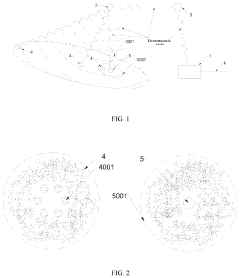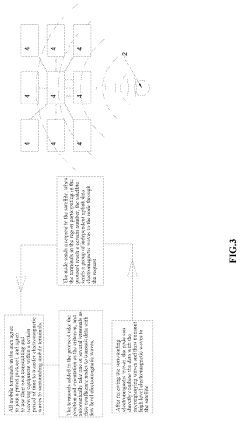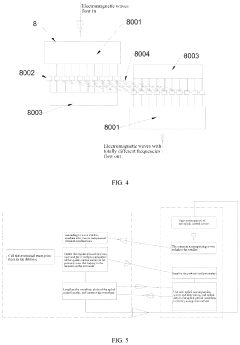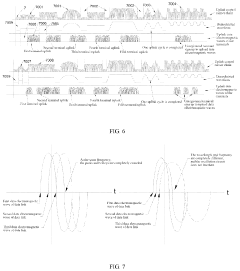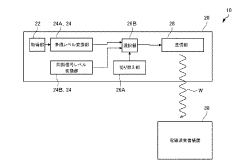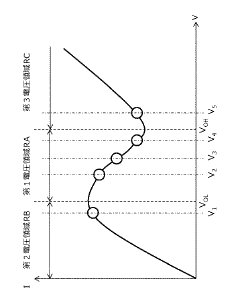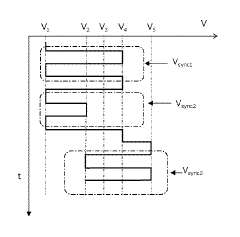How to Design Cutting-Edge Electromagnetic Wave Transmission Systems?
JUL 11, 20259 MIN READ
Generate Your Research Report Instantly with AI Agent
Patsnap Eureka helps you evaluate technical feasibility & market potential.
EM Wave System Evolution and Objectives
Electromagnetic wave transmission systems have undergone significant evolution since their inception in the late 19th century. The journey from Hertz's experiments to today's cutting-edge 5G networks represents a remarkable progression in our ability to harness and manipulate electromagnetic waves for communication purposes.
The early developments in this field were primarily focused on basic radio transmission and reception. Marconi's successful transatlantic radio transmission in 1901 marked a pivotal moment, demonstrating the potential of long-distance wireless communication. As technology advanced, the focus shifted towards improving signal quality, increasing transmission distances, and expanding bandwidth capabilities.
The mid-20th century saw the emergence of microwave communication systems, which enabled higher frequency transmissions and paved the way for satellite communications. This period also witnessed the development of radar technology, which found applications in both military and civilian sectors.
The advent of digital technology in the latter half of the 20th century revolutionized electromagnetic wave transmission systems. Digital modulation techniques, error correction algorithms, and advanced signal processing methods dramatically improved the efficiency and reliability of wireless communications.
In recent decades, the explosive growth of mobile communications has driven rapid advancements in electromagnetic wave transmission systems. The evolution from 1G to 5G cellular networks has been characterized by exponential increases in data rates, reduced latency, and improved spectral efficiency.
Looking ahead, the objectives for cutting-edge electromagnetic wave transmission systems are multifaceted. One primary goal is to further increase data transmission rates to meet the ever-growing demand for high-bandwidth applications such as augmented reality, virtual reality, and the Internet of Things (IoT).
Another critical objective is to improve energy efficiency in transmission systems. As the number of connected devices continues to grow, reducing power consumption becomes increasingly important for both environmental and economic reasons.
Enhancing spectral efficiency remains a key focus, as the radio frequency spectrum is a finite resource. Advanced techniques such as massive MIMO (Multiple-Input Multiple-Output), beamforming, and cognitive radio are being explored to maximize the utilization of available spectrum.
Improving reliability and reducing latency are also crucial objectives, particularly for applications like autonomous vehicles and remote surgery, which require near-instantaneous and error-free communication.
Finally, there is a growing emphasis on developing flexible and adaptable transmission systems that can operate across a wide range of frequencies and environments. This includes exploring higher frequency bands, such as millimeter-wave and terahertz frequencies, to open up new possibilities for high-capacity communications.
The early developments in this field were primarily focused on basic radio transmission and reception. Marconi's successful transatlantic radio transmission in 1901 marked a pivotal moment, demonstrating the potential of long-distance wireless communication. As technology advanced, the focus shifted towards improving signal quality, increasing transmission distances, and expanding bandwidth capabilities.
The mid-20th century saw the emergence of microwave communication systems, which enabled higher frequency transmissions and paved the way for satellite communications. This period also witnessed the development of radar technology, which found applications in both military and civilian sectors.
The advent of digital technology in the latter half of the 20th century revolutionized electromagnetic wave transmission systems. Digital modulation techniques, error correction algorithms, and advanced signal processing methods dramatically improved the efficiency and reliability of wireless communications.
In recent decades, the explosive growth of mobile communications has driven rapid advancements in electromagnetic wave transmission systems. The evolution from 1G to 5G cellular networks has been characterized by exponential increases in data rates, reduced latency, and improved spectral efficiency.
Looking ahead, the objectives for cutting-edge electromagnetic wave transmission systems are multifaceted. One primary goal is to further increase data transmission rates to meet the ever-growing demand for high-bandwidth applications such as augmented reality, virtual reality, and the Internet of Things (IoT).
Another critical objective is to improve energy efficiency in transmission systems. As the number of connected devices continues to grow, reducing power consumption becomes increasingly important for both environmental and economic reasons.
Enhancing spectral efficiency remains a key focus, as the radio frequency spectrum is a finite resource. Advanced techniques such as massive MIMO (Multiple-Input Multiple-Output), beamforming, and cognitive radio are being explored to maximize the utilization of available spectrum.
Improving reliability and reducing latency are also crucial objectives, particularly for applications like autonomous vehicles and remote surgery, which require near-instantaneous and error-free communication.
Finally, there is a growing emphasis on developing flexible and adaptable transmission systems that can operate across a wide range of frequencies and environments. This includes exploring higher frequency bands, such as millimeter-wave and terahertz frequencies, to open up new possibilities for high-capacity communications.
Market Demand Analysis
The market demand for cutting-edge electromagnetic wave transmission systems has been experiencing significant growth in recent years, driven by the rapid advancement of wireless communication technologies and the increasing need for high-speed, reliable data transmission across various industries. This demand is particularly evident in sectors such as telecommunications, aerospace, defense, and emerging technologies like 5G and beyond.
In the telecommunications sector, the rollout of 5G networks has created a surge in demand for advanced electromagnetic wave transmission systems. These systems are crucial for enabling the high-speed, low-latency communication promised by 5G technology. As more countries and regions adopt 5G infrastructure, the market for these transmission systems is expected to expand substantially.
The aerospace and defense industries also contribute significantly to the market demand. Modern aircraft and military equipment rely heavily on sophisticated electromagnetic wave transmission systems for communication, navigation, and radar applications. The need for secure, long-range, and interference-resistant communication in these sectors continues to drive innovation and demand for cutting-edge solutions.
Emerging technologies such as Internet of Things (IoT) and smart cities are further fueling the market growth. These applications require robust and efficient electromagnetic wave transmission systems to support the vast network of interconnected devices and sensors. The increasing adoption of IoT across industries is expected to create a sustained demand for advanced transmission systems in the coming years.
The automotive industry is another key driver of market demand, particularly with the development of autonomous vehicles. These vehicles require reliable and high-performance electromagnetic wave transmission systems for vehicle-to-vehicle (V2V) and vehicle-to-infrastructure (V2I) communication, as well as for various onboard sensors and systems.
In terms of market size, the global electromagnetic wave transmission systems market is projected to grow at a compound annual growth rate (CAGR) of over 6% from 2021 to 2026. This growth is attributed to the increasing investments in 5G infrastructure, the rising demand for high-speed internet connectivity, and the growing adoption of wireless technologies across various industries.
Geographically, North America and Asia-Pacific are expected to be the leading markets for electromagnetic wave transmission systems. The strong presence of technology companies, ongoing research and development activities, and early adoption of advanced technologies contribute to the market growth in these regions. Europe is also anticipated to witness significant growth, driven by investments in 5G infrastructure and smart city initiatives.
In the telecommunications sector, the rollout of 5G networks has created a surge in demand for advanced electromagnetic wave transmission systems. These systems are crucial for enabling the high-speed, low-latency communication promised by 5G technology. As more countries and regions adopt 5G infrastructure, the market for these transmission systems is expected to expand substantially.
The aerospace and defense industries also contribute significantly to the market demand. Modern aircraft and military equipment rely heavily on sophisticated electromagnetic wave transmission systems for communication, navigation, and radar applications. The need for secure, long-range, and interference-resistant communication in these sectors continues to drive innovation and demand for cutting-edge solutions.
Emerging technologies such as Internet of Things (IoT) and smart cities are further fueling the market growth. These applications require robust and efficient electromagnetic wave transmission systems to support the vast network of interconnected devices and sensors. The increasing adoption of IoT across industries is expected to create a sustained demand for advanced transmission systems in the coming years.
The automotive industry is another key driver of market demand, particularly with the development of autonomous vehicles. These vehicles require reliable and high-performance electromagnetic wave transmission systems for vehicle-to-vehicle (V2V) and vehicle-to-infrastructure (V2I) communication, as well as for various onboard sensors and systems.
In terms of market size, the global electromagnetic wave transmission systems market is projected to grow at a compound annual growth rate (CAGR) of over 6% from 2021 to 2026. This growth is attributed to the increasing investments in 5G infrastructure, the rising demand for high-speed internet connectivity, and the growing adoption of wireless technologies across various industries.
Geographically, North America and Asia-Pacific are expected to be the leading markets for electromagnetic wave transmission systems. The strong presence of technology companies, ongoing research and development activities, and early adoption of advanced technologies contribute to the market growth in these regions. Europe is also anticipated to witness significant growth, driven by investments in 5G infrastructure and smart city initiatives.
Current Challenges in EM Wave Transmission
Electromagnetic wave transmission systems face several significant challenges in the current technological landscape. One of the primary issues is signal attenuation, which becomes increasingly problematic as transmission distances grow longer. This phenomenon results in weakened signals and reduced data rates, particularly in wireless communication systems operating at higher frequencies.
Another critical challenge is interference management. As the electromagnetic spectrum becomes more crowded with various wireless technologies, designing systems that can effectively mitigate interference from other sources while maintaining signal integrity is becoming increasingly complex. This issue is particularly acute in urban environments and industrial settings where multiple wireless systems coexist.
The demand for higher data rates and increased bandwidth poses another significant hurdle. As applications require more data to be transmitted faster, designers must find innovative ways to maximize spectral efficiency and develop advanced modulation techniques. This challenge is closely tied to the limitations of current hardware capabilities, including antenna design and signal processing technologies.
Energy efficiency is also a growing concern in electromagnetic wave transmission systems. With the proliferation of mobile devices and the expansion of wireless networks, there is a pressing need to develop transmission systems that consume less power while maintaining or improving performance. This challenge extends to both the transmitter and receiver sides of the communication link.
Multipath propagation presents another complex issue, especially in urban and indoor environments. The reflection, diffraction, and scattering of electromagnetic waves can lead to signal distortion and fading, requiring sophisticated signal processing techniques to overcome these effects and ensure reliable communication.
Security and privacy concerns have also become paramount in electromagnetic wave transmission systems. As more sensitive data is transmitted wirelessly, protecting this information from interception and ensuring the integrity of communications has become a critical design consideration.
Lastly, the push towards higher frequency bands, such as millimeter-wave and terahertz frequencies, introduces new challenges in terms of signal propagation, component design, and system integration. These higher frequencies offer the potential for increased bandwidth but also face greater attenuation and are more susceptible to environmental factors.
Addressing these challenges requires a multidisciplinary approach, combining advancements in antenna design, signal processing algorithms, materials science, and system-level optimization. As researchers and engineers work to overcome these hurdles, the field of electromagnetic wave transmission continues to evolve, driving innovation in wireless communications and related technologies.
Another critical challenge is interference management. As the electromagnetic spectrum becomes more crowded with various wireless technologies, designing systems that can effectively mitigate interference from other sources while maintaining signal integrity is becoming increasingly complex. This issue is particularly acute in urban environments and industrial settings where multiple wireless systems coexist.
The demand for higher data rates and increased bandwidth poses another significant hurdle. As applications require more data to be transmitted faster, designers must find innovative ways to maximize spectral efficiency and develop advanced modulation techniques. This challenge is closely tied to the limitations of current hardware capabilities, including antenna design and signal processing technologies.
Energy efficiency is also a growing concern in electromagnetic wave transmission systems. With the proliferation of mobile devices and the expansion of wireless networks, there is a pressing need to develop transmission systems that consume less power while maintaining or improving performance. This challenge extends to both the transmitter and receiver sides of the communication link.
Multipath propagation presents another complex issue, especially in urban and indoor environments. The reflection, diffraction, and scattering of electromagnetic waves can lead to signal distortion and fading, requiring sophisticated signal processing techniques to overcome these effects and ensure reliable communication.
Security and privacy concerns have also become paramount in electromagnetic wave transmission systems. As more sensitive data is transmitted wirelessly, protecting this information from interception and ensuring the integrity of communications has become a critical design consideration.
Lastly, the push towards higher frequency bands, such as millimeter-wave and terahertz frequencies, introduces new challenges in terms of signal propagation, component design, and system integration. These higher frequencies offer the potential for increased bandwidth but also face greater attenuation and are more susceptible to environmental factors.
Addressing these challenges requires a multidisciplinary approach, combining advancements in antenna design, signal processing algorithms, materials science, and system-level optimization. As researchers and engineers work to overcome these hurdles, the field of electromagnetic wave transmission continues to evolve, driving innovation in wireless communications and related technologies.
State-of-the-Art EM Wave Solutions
01 Wireless power transmission systems
Electromagnetic wave transmission systems for wireless power transfer focus on improving transmission efficiency. These systems utilize various techniques to optimize power transfer between transmitters and receivers, minimizing energy loss during transmission. Advanced designs incorporate resonant coupling and adaptive frequency tuning to enhance efficiency across different distances and environmental conditions.- Beamforming techniques for improved transmission efficiency: Beamforming techniques are used to focus electromagnetic waves in specific directions, enhancing signal strength and improving transmission efficiency. This approach involves adjusting the phase and amplitude of signals from multiple antennas to create constructive interference in desired directions and destructive interference in others, resulting in better signal quality and reduced power consumption.
- Adaptive power control systems: Adaptive power control systems dynamically adjust the transmission power based on various factors such as distance, signal quality, and environmental conditions. These systems optimize power usage, reduce interference, and improve overall transmission efficiency by ensuring that only the necessary amount of power is used for successful signal transmission.
- Advanced modulation and coding schemes: Implementation of advanced modulation and coding schemes allows for more efficient use of the available spectrum. These techniques enable the transmission of more data bits per symbol, increasing the overall data throughput while maintaining or improving error correction capabilities, thus enhancing the efficiency of electromagnetic wave transmission systems.
- MIMO (Multiple-Input Multiple-Output) technology: MIMO technology utilizes multiple antennas at both the transmitter and receiver to exploit multipath propagation. This approach increases channel capacity, improves spectral efficiency, and enhances link reliability without requiring additional bandwidth or transmit power, leading to significant improvements in transmission efficiency.
- Adaptive impedance matching techniques: Adaptive impedance matching techniques dynamically adjust the impedance of the transmission system to match the antenna impedance under varying conditions. This approach minimizes signal reflections, reduces power loss, and improves overall transmission efficiency by ensuring maximum power transfer between the transmitter and the antenna.
02 Antenna design for improved transmission efficiency
Innovative antenna designs play a crucial role in enhancing electromagnetic wave transmission efficiency. These designs focus on optimizing radiation patterns, impedance matching, and polarization to maximize signal strength and minimize losses. Advanced materials and structures are employed to create high-performance antennas suitable for various applications and frequency ranges.Expand Specific Solutions03 Beamforming and MIMO technologies
Beamforming and Multiple-Input Multiple-Output (MIMO) technologies are employed to improve electromagnetic wave transmission efficiency. These techniques focus on directing signals towards specific receivers and utilizing multiple antennas to increase data throughput and reliability. Advanced signal processing algorithms are used to optimize transmission paths and reduce interference.Expand Specific Solutions04 Adaptive modulation and coding schemes
Adaptive modulation and coding schemes are implemented to enhance transmission efficiency in electromagnetic wave systems. These techniques dynamically adjust signal parameters based on channel conditions, optimizing data rates and reducing errors. Advanced algorithms are used to select the most appropriate modulation and coding methods for varying transmission environments.Expand Specific Solutions05 Waveguide and transmission line optimization
Optimization of waveguides and transmission lines is crucial for improving electromagnetic wave transmission efficiency. This involves designing structures that minimize signal attenuation and distortion over long distances. Advanced materials and geometries are employed to reduce losses and maintain signal integrity across a wide range of frequencies.Expand Specific Solutions
Key Industry Players
The electromagnetic wave transmission systems market is in a growth phase, driven by increasing demand for high-speed communication and advanced wireless technologies. The market size is expanding rapidly, with significant investments in 5G and IoT applications. Technologically, the field is evolving quickly, with companies like Huawei, NEC, and STMicroelectronics leading innovation. These firms are developing cutting-edge solutions in antenna design, signal processing, and materials science. Universities such as the University of Tokyo and research institutions like RIKEN are contributing to fundamental advancements, while companies like Mitsubishi Electric and Hitachi are focusing on practical applications and system integration.
NEC Corp.
Technical Solution: NEC has developed innovative electromagnetic wave transmission systems focusing on high-frequency and terahertz communications. Their approach includes the use of photonics-based technologies for generating and detecting terahertz waves, enabling ultra-high-speed wireless communications[5]. NEC has also implemented advanced digital signal processing techniques to compensate for atmospheric attenuation and multipath fading in high-frequency bands[6]. Their systems incorporate adaptive modulation and coding schemes to optimize transmission parameters based on channel conditions, ensuring reliable communication even in challenging environments[7]. Furthermore, NEC has developed compact, energy-efficient antenna arrays for beamforming in small cell deployments, enhancing coverage and capacity in urban areas[8].
Strengths: Expertise in terahertz communications and advanced signal processing. Weaknesses: Limited market penetration compared to some competitors in the 5G space.
Huawei Technologies Co., Ltd.
Technical Solution: Huawei has developed cutting-edge electromagnetic wave transmission systems using advanced 5G and 6G technologies. Their approach includes massive MIMO (Multiple-Input Multiple-Output) antennas, which significantly increase network capacity and spectral efficiency[1]. Huawei's systems utilize beamforming techniques to focus signal energy towards specific users, improving signal quality and reducing interference[2]. They have also implemented full-duplex communication, allowing simultaneous transmission and reception on the same frequency, effectively doubling spectral efficiency[3]. Additionally, Huawei has pioneered the use of millimeter-wave (mmWave) frequencies for high-bandwidth, low-latency communications, enabling multi-gigabit data rates[4].
Strengths: Industry-leading 5G/6G technology, high spectral efficiency, and advanced signal processing. Weaknesses: Potential security concerns and geopolitical challenges in some markets.
Core EM Wave Innovations
Method and System for Electromagnetic Wave Data Transmission
PatentActiveUS20210119693A1
Innovation
- A system comprising a ground main information node, communication satellite, relay satellite, and uplink control carrier, utilizing independent electromagnetic waves and adaptive modulation to enhance data transmission speed and security, while reducing interference and energy consumption by employing multiple antenna emission units and position referencing techniques.
Electromagnetic wave transmitter and electromagnetic wave communication system
PatentActiveJPWO2020145236A1
Innovation
- A transmission unit with a voltage-current characteristic having specific voltage regions and an acquisition unit that acquires digital signals, utilizing multiple voltage levels to modulate electromagnetic waves, specifically terahertz waves, for enhanced communication speed.
Regulatory Framework for EM Systems
The regulatory framework for electromagnetic (EM) wave transmission systems plays a crucial role in ensuring the safe, efficient, and harmonious operation of these technologies. Governments and international bodies have established comprehensive guidelines and standards to govern the design, implementation, and use of EM systems across various sectors.
At the international level, the International Telecommunication Union (ITU) sets global standards for radio frequency allocation and usage. The ITU's Radio Regulations define the allocation of frequency bands to different services and establish technical parameters for their operation. These regulations are periodically updated through World Radiocommunication Conferences to address emerging technologies and changing needs.
In the United States, the Federal Communications Commission (FCC) is responsible for regulating interstate and international communications by radio, television, wire, satellite, and cable. The FCC's regulations cover a wide range of EM systems, including wireless communications, broadcasting, and industrial applications. The agency enforces strict guidelines on frequency allocation, power limits, and interference prevention.
The European Union has established the Radio Equipment Directive (RED) to ensure that radio equipment, including EM transmission systems, meets essential requirements for safety, electromagnetic compatibility, and efficient use of the radio spectrum. Member states implement these directives through national legislation, creating a harmonized regulatory environment across the EU.
Safety considerations are paramount in the regulatory framework for EM systems. Exposure limits to electromagnetic fields (EMF) are set by organizations such as the International Commission on Non-Ionizing Radiation Protection (ICNIRP) and adopted by many countries. These limits are designed to protect both workers and the general public from potential health effects associated with EM radiation.
Electromagnetic compatibility (EMC) regulations are another critical aspect of the regulatory framework. These rules ensure that EM systems do not interfere with other electronic devices and can operate in their intended electromagnetic environment. Standards organizations like the International Electrotechnical Commission (IEC) develop EMC standards that are widely adopted globally.
As new technologies emerge, regulatory frameworks must evolve to address novel challenges. For instance, the development of 5G networks has prompted regulators to reassess spectrum allocation and update EMF exposure guidelines. Similarly, the increasing use of EM systems in autonomous vehicles and IoT devices is driving the need for new regulatory approaches.
Compliance with these regulatory frameworks is essential for designers and manufacturers of cutting-edge EM transmission systems. It requires careful consideration of frequency allocation, power output, EMC, and safety standards throughout the design process. Additionally, obtaining necessary certifications and approvals from relevant regulatory bodies is crucial for market access and legal operation of EM systems.
At the international level, the International Telecommunication Union (ITU) sets global standards for radio frequency allocation and usage. The ITU's Radio Regulations define the allocation of frequency bands to different services and establish technical parameters for their operation. These regulations are periodically updated through World Radiocommunication Conferences to address emerging technologies and changing needs.
In the United States, the Federal Communications Commission (FCC) is responsible for regulating interstate and international communications by radio, television, wire, satellite, and cable. The FCC's regulations cover a wide range of EM systems, including wireless communications, broadcasting, and industrial applications. The agency enforces strict guidelines on frequency allocation, power limits, and interference prevention.
The European Union has established the Radio Equipment Directive (RED) to ensure that radio equipment, including EM transmission systems, meets essential requirements for safety, electromagnetic compatibility, and efficient use of the radio spectrum. Member states implement these directives through national legislation, creating a harmonized regulatory environment across the EU.
Safety considerations are paramount in the regulatory framework for EM systems. Exposure limits to electromagnetic fields (EMF) are set by organizations such as the International Commission on Non-Ionizing Radiation Protection (ICNIRP) and adopted by many countries. These limits are designed to protect both workers and the general public from potential health effects associated with EM radiation.
Electromagnetic compatibility (EMC) regulations are another critical aspect of the regulatory framework. These rules ensure that EM systems do not interfere with other electronic devices and can operate in their intended electromagnetic environment. Standards organizations like the International Electrotechnical Commission (IEC) develop EMC standards that are widely adopted globally.
As new technologies emerge, regulatory frameworks must evolve to address novel challenges. For instance, the development of 5G networks has prompted regulators to reassess spectrum allocation and update EMF exposure guidelines. Similarly, the increasing use of EM systems in autonomous vehicles and IoT devices is driving the need for new regulatory approaches.
Compliance with these regulatory frameworks is essential for designers and manufacturers of cutting-edge EM transmission systems. It requires careful consideration of frequency allocation, power output, EMC, and safety standards throughout the design process. Additionally, obtaining necessary certifications and approvals from relevant regulatory bodies is crucial for market access and legal operation of EM systems.
Environmental Impact Assessment
The environmental impact of cutting-edge electromagnetic wave transmission systems is a critical consideration in their design and implementation. These systems, while essential for modern communication and technology, can have significant effects on the surrounding ecosystem and human health if not properly managed.
Electromagnetic radiation emitted by these systems can potentially interfere with wildlife behavior and migration patterns. Studies have shown that certain species, particularly birds and insects, may be sensitive to electromagnetic fields, potentially affecting their navigation and breeding habits. Long-term exposure to high-frequency electromagnetic waves may also impact plant growth and soil microorganisms, although more research is needed to fully understand these effects.
Human health concerns are another crucial aspect of the environmental impact assessment. While current scientific consensus suggests that exposure to low-level electromagnetic fields does not pose significant health risks, public perception and concerns about potential long-term effects remain. Designers must consider these factors and implement appropriate shielding and safety measures to minimize human exposure, especially in densely populated areas.
The physical infrastructure required for advanced transmission systems also has environmental implications. The construction of towers, antennas, and supporting facilities can lead to habitat fragmentation and visual pollution. In urban areas, the proliferation of small cell sites for 5G networks raises concerns about the aesthetic impact on cityscapes and historical areas. Careful site selection and innovative design solutions are necessary to mitigate these issues.
Energy consumption is another environmental consideration. Cutting-edge transmission systems often require significant power to operate, contributing to overall energy demand and associated carbon emissions. Designers must focus on developing energy-efficient technologies and exploring renewable energy sources to power these systems, reducing their carbon footprint.
Electromagnetic interference with other electronic devices and systems is also a potential environmental concern. Advanced transmission systems must be designed to minimize interference with medical devices, aviation equipment, and other critical infrastructure to ensure public safety and operational reliability.
Recycling and waste management of electronic components used in these systems present additional environmental challenges. The rapid evolution of technology often leads to frequent upgrades and replacements, potentially generating significant electronic waste. Designers should consider the entire lifecycle of the system, incorporating recyclable materials and modular designs to facilitate easier upgrades and reduce e-waste.
In conclusion, the environmental impact assessment of cutting-edge electromagnetic wave transmission systems must be comprehensive, addressing radiation effects, physical infrastructure, energy consumption, interference, and waste management. By integrating these considerations into the design process, engineers can develop more sustainable and environmentally friendly transmission systems that balance technological advancement with ecological responsibility.
Electromagnetic radiation emitted by these systems can potentially interfere with wildlife behavior and migration patterns. Studies have shown that certain species, particularly birds and insects, may be sensitive to electromagnetic fields, potentially affecting their navigation and breeding habits. Long-term exposure to high-frequency electromagnetic waves may also impact plant growth and soil microorganisms, although more research is needed to fully understand these effects.
Human health concerns are another crucial aspect of the environmental impact assessment. While current scientific consensus suggests that exposure to low-level electromagnetic fields does not pose significant health risks, public perception and concerns about potential long-term effects remain. Designers must consider these factors and implement appropriate shielding and safety measures to minimize human exposure, especially in densely populated areas.
The physical infrastructure required for advanced transmission systems also has environmental implications. The construction of towers, antennas, and supporting facilities can lead to habitat fragmentation and visual pollution. In urban areas, the proliferation of small cell sites for 5G networks raises concerns about the aesthetic impact on cityscapes and historical areas. Careful site selection and innovative design solutions are necessary to mitigate these issues.
Energy consumption is another environmental consideration. Cutting-edge transmission systems often require significant power to operate, contributing to overall energy demand and associated carbon emissions. Designers must focus on developing energy-efficient technologies and exploring renewable energy sources to power these systems, reducing their carbon footprint.
Electromagnetic interference with other electronic devices and systems is also a potential environmental concern. Advanced transmission systems must be designed to minimize interference with medical devices, aviation equipment, and other critical infrastructure to ensure public safety and operational reliability.
Recycling and waste management of electronic components used in these systems present additional environmental challenges. The rapid evolution of technology often leads to frequent upgrades and replacements, potentially generating significant electronic waste. Designers should consider the entire lifecycle of the system, incorporating recyclable materials and modular designs to facilitate easier upgrades and reduce e-waste.
In conclusion, the environmental impact assessment of cutting-edge electromagnetic wave transmission systems must be comprehensive, addressing radiation effects, physical infrastructure, energy consumption, interference, and waste management. By integrating these considerations into the design process, engineers can develop more sustainable and environmentally friendly transmission systems that balance technological advancement with ecological responsibility.
Unlock deeper insights with Patsnap Eureka Quick Research — get a full tech report to explore trends and direct your research. Try now!
Generate Your Research Report Instantly with AI Agent
Supercharge your innovation with Patsnap Eureka AI Agent Platform!
